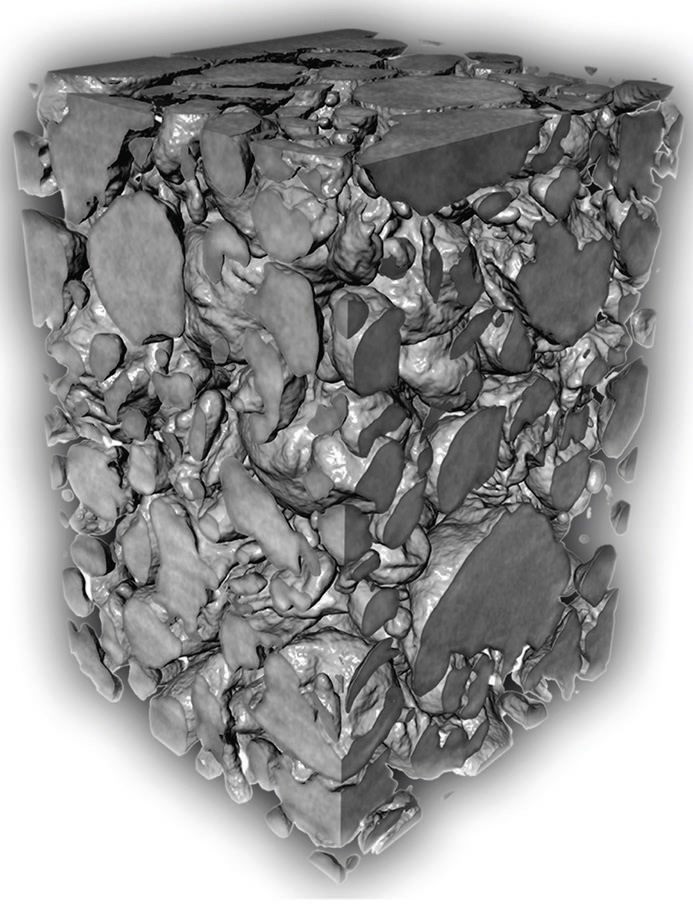Thubber: A new thermally conductive elastomer
Dr. Neil Canter, Contributing Editor | TLT Tech Beat June 2017
The new substance displays a 25 times increase in thermal conductivity under stress-free conditions.
KEY CONCEPTS
•
Elastomers used in applications such as seals are not thermally conductive.
•
Suspension of liquid metal droplets in a silicone elastomer produced a thermal composite that exhibits 25 times the thermal conductivity compared to the base elastomer.
•
The thermal conductivity determined for the liquid metal embedded elastomer is comparable to metals such as bismuth and stainless steel.
THE SEARCH CONTINUES FOR NEW MATERIALS that provide better performance and are lighter in weight. This leads to the potential for machinery using these materials to be more productive with better operating efficiency.
One area of major concern is oxidation resistance. A past TLT article describes the development of a boride based on molybdenum, boron and aluminum that can display oxidation resistance up to a temperature of 1,300 C (
1). This feature may enable future use of this material, not just as a surface coating (its main current use) but as a bulk material.
Seals perform an important function to minimize the movement of lubricants out of a specific machine and also to prevent contaminants such as dust, dirt and water from coming into contact with the lubricant. Elastomers used as seals include nitriles, fluoroelastomers, polyurethanes and EPDM.
One challenge in working with elastomers is that they are not thermally conductive. Excessive heat build-up in lubricant systems can lead to premature failure. Carmel Majidi, associate professor of mechanical engineering at Carnegie Mellon University in Pittsburgh, says, “There is a tradeoff between a material’s thermal conductivity and flexibility. Soft materials such as elastomers are not able to conduct heat effectively because the only way to move heat is through vibrations in the polymer that are known as phonons. The speed of propagation of phonons is directly proportional to the stiffness of the polymer.”
Attempts to improve thermal conductivity mainly involved the use of rigid fillers such as metals, ceramics and carbon fibers. Majidi says, “The addition of these rigid particles to the polymer matrix enables heat to jump from particle to particle, leading to better conductivity. The problem is that the particles altered the mechanical properties of the newly formed composite. No longer was the composite a soft, elastic material.”
A new approach is needed to prepare an elastomer that can effectively conduct heat. Such a material now has been developed.
LIQUID METAL DISPERSION
Majidi and his colleagues suspended liquid metal droplets in a silicone elastomer to produce a material known as a liquid metal embedded elastomer (LMEE). This thermal composite is prepared by shear mixing a liquid metal alloy with an uncured silicone elastomer. It is known as Thubber.
The liquid metal alloy used by the researchers was a liquid phase eutectic gallium-indium containing 75% gallium and 25% indium by weight. Majidi says, “We have a history of working with liquid metal alloys and know that they are mechanically compliant and malleable.”
The LMEE displays a 25 times increase in thermal conductivity compared to the original silicone elastomer used under stress-free conditions and a 50 times increase when strained. These results were achieved without compromising the elastic properties of the silicone elastomer.
Majidi says, “The liquid metal dispersion produces the enhanced thermal conductivity through a unique thermal-mechanical coupling into needle-like structures along a mechanically loaded direction that leads to the formation of thermally conductive pathways facilitating thermal conductivity.”
The liquid metal droplets were irregular in shape and ranged from one to 10 microns in size. Majidi indicates that no surfactant or dispersing agent is needed to prepare the dispersion. He says, “The liquid metal alloy oxidizes under the mixing conditions to form a self-passivating gallium (III) oxide coating that prevents coalescence. Figure 2 shows an image of the LMEE.
 Figure 2. The addition of irregularly shaped liquid metal droplets to a silicone elastomer produces a material, nicknamed Thubber, that exhibits a significant increase in thermal conductivity. (Figure courtesy of Carnegie Mellon University.)
Figure 2. The addition of irregularly shaped liquid metal droplets to a silicone elastomer produces a material, nicknamed Thubber, that exhibits a significant increase in thermal conductivity. (Figure courtesy of Carnegie Mellon University.)
Thermal conductivity testing was done through working with Jonathan Malen, associate professor of mechanical engineering at Carnegie Mellon, using a technique known as the transient hot wire (THW) method. Majidi says, “Wires were embedded into the LMEE and electric current is passed through them. The wires act both as a resistant heat source and as a thermometer to measure changes in temperature as a function of time.”
The researchers measured the thermal conductivity as the LMEE is stretched. While the thermal conductivity in the transverse direction changes little, an increase of 50 times the base silicone elastomer is seen in the stretched (axial) direction when the LMEE is stretched at 400% strain.
This degree of thermal conductivity is comparable to metals such as bismuth and stainless steel. Majidi says, “Our approach for using liquid metal alloys was originally conduced with a silicone elastomer, but it can easily be reproduced with other elastomers.”
Two applications have been identified for the LMEE. Majidi says, “We have used the LMEE as a stretchable mount for an LED light that can be used as a safety lamp worn around a jogger’s leg. These devices need large amounts of power and generate heat, which is difficult to deal with if it is close to someone’s skin. The LMEE acts to facilitate heat removal.”
A second application is use of the LMEE as a tail in a soft robotic fish. The tail is a thermal actuator that converts heat into mechanical motion enabling the fish to swim. Majidi anticipates that the LMEE can be used in other flexible electronics applications.
From a lubricant standpoint, LMEE may represent an opportunity for development of a seal that rapidly dissipates heat, which could lead to extending the operating life of a lubricant in a specific application.
Additional information can be found in a recent paper (
2) or by contacting Majidi at
cmajidi@andrew.cmu.edu.
REFERENCES
1.
Canter, N. (2016), “Oxidation-resistant molybdenum boride,” TLT,
72 (11), pp. 12-13.
2.
Bartlett, M., Kazem, N., Powell-Palm, M., Huang, X., Sun, W., Malen, J. and Majidi, C., (2017), “High thermal conductivity in soft elastomers with elongated liquid metal inclusions,”
Proceedings of the National Academy of Sciences,
114 (9), pp. 2143-2148.
 Neil Canter heads his own consulting company, Chemical Solutions, in Willow Grove, Pa. Ideas for Tech Beat items can be sent to him at neilcanter@comcast.net
Neil Canter heads his own consulting company, Chemical Solutions, in Willow Grove, Pa. Ideas for Tech Beat items can be sent to him at neilcanter@comcast.net.